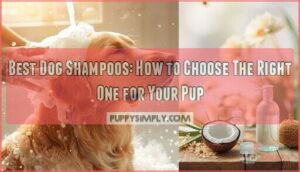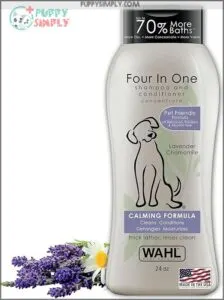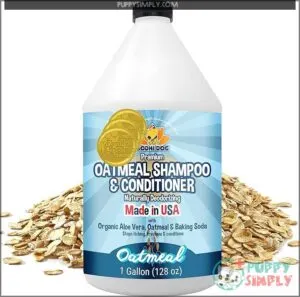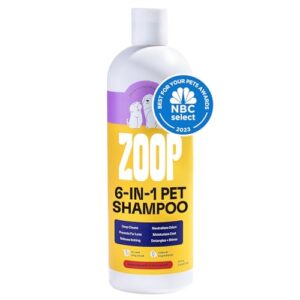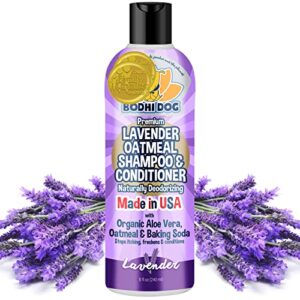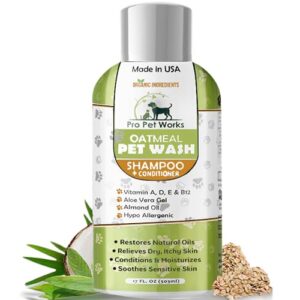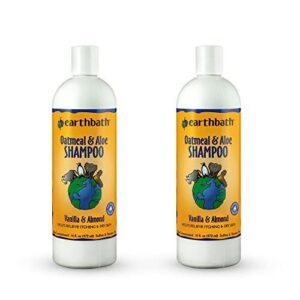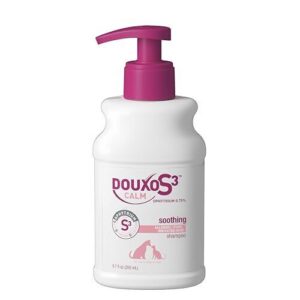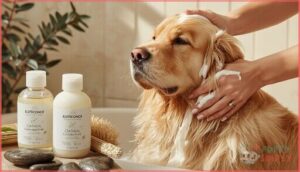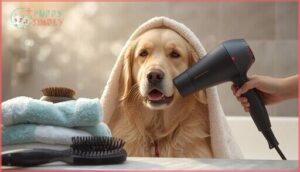This site is supported by our readers. We may earn a commission, at no cost to you, if you purchase through links.
Your dog’s shampoo bottle might be doing more harm than good. Most pet owners don’t realize that a dog’s skin sits at a pH level of 7.5, markedly different from our acidic 5.5—which means that ‘just a quick wash’ with human shampoo can trigger irritation, dryness, and even infections.
The pet care aisle presents dozens of options, from budget bottles to premium formulas, but choosing the best dog shampoo isn’t about price tags or fancy packaging. It’s about understanding what your pup’s skin actually needs: gentle, pH-balanced cleansers with ingredients you can recognize and pronounce.
Whether you’re managing a puppy’s delicate skin, soothing an itchy senior, or maintaining a double coat’s natural oils, the right shampoo protects your dog’s largest organ while keeping their coat healthy and vibrant.
Table Of Contents
- Key Takeaways
- Key Factors in Choosing Dog Shampoo
- Understanding Dog Skin and Coat Needs
- Ingredients to Seek and Avoid
- Top 8 Dog Shampoos Reviewed
- 1. Wahl Calming Lavender Chamomile Dog Shampoo
- 2. Natural Oatmeal Pet Shampoo Conditioner
- 3. Natural Dog Shampoo And Conditioner
- 4. Natural Pet Shampoo And Conditioner
- 5. Natural Oatmeal Dog Shampoo Conditioner
- 6. Natural Oatmeal Dog Shampoo Relief
- 7. Burt’s Bees Oatmeal Dog Shampoo
- 8. Soothing Shampoo For Itchy Pets
- Tips for Bathing and Grooming Your Dog
- Frequently Asked Questions (FAQs)
- What if my dog hates bath time?
- How often should I wash my dog?
- Are human shampoos ever safe for dogs?
- How do I know if my dog has sensitive skin?
- Are fragrance-free shampoos better?
- Can I use baby shampoo on my dog?
- How do I store dog shampoo properly?
- What if my dog eats some shampoo?
- Do waterless shampoos work as well as regular?
- Should I dilute concentrated dog shampoo formulas?
- Conclusion
Key Takeaways
- Dogs’ skin pH (around 7.5) differs significantly from humans’ (5.5), so using human shampoo disrupts their natural protective barrier and can trigger irritation, dryness, and infections.
- The best dog shampoos prioritize pH-balanced, hypoallergenic formulas with recognizable natural ingredients like oatmeal, aloe vera, and coconut oil while avoiding harsh chemicals such as sulfates, parabens, and artificial fragrances.
- Your dog’s specific needs—including coat type, age, skin sensitivities, and lifestyle—should guide your shampoo choice, as puppies need gentler tearless formulas while seniors benefit from moisturizing options.
- Proper bathing technique matters as much as product choice: dilute concentrated formulas correctly, rinse thoroughly to prevent residue buildup, and watch for post-bath signs of irritation like redness or excessive scratching.
Key Factors in Choosing Dog Shampoo
Picking the right dog shampoo isn’t just about grabbing whatever’s on the shelf—it’s about understanding what your pup actually needs. There are some key things to look for that can make a real difference in your dog’s skin and coat health.
Let’s walk through the most important factors that should guide your choice.
PH Balance for Dog Skin
Your dog’s skin isn’t like yours—it’s naturally more alkaline, typically ranging from pH 6.2 to 7.4 compared to your acidic skin around pH 4.5. Using human shampoo disrupts this delicate balance, stripping natural oils and weakening your pup’s skin barrier.
Dogs’ skin is naturally alkaline, so human shampoo disrupts their pH balance and strips away protective oils
That’s why pH-balanced dog shampoos matter: they maintain canine skin health without triggering irritation, dryness, or infections. The right formula keeps your dog comfortable and protected.
Understanding the importance of pH balance levels is essential for selecting the best dog shampoo.
Importance of Simple, Safe Ingredients
Now that you understand pH balance, let’s talk about what goes into your dog’s shampoo—because simplicity truly matters here. Your pup’s skin is sensitive, and unnecessary ingredients create needless irritation risks.
Research shows skin allergies cost owners hundreds to thousands annually. That’s why gentle cleansers and minimal ingredients make a real difference. Look for these qualities:
- Natural formulas with oatmeal, aloe, or coconut oil
- Safe preservatives that protect without harming skin bacteria
- Hypoallergenic options free from artificial fragrances
- Short ingredient lists you can actually understand
- pH-balanced formulations designed specifically for dogs
Your dog deserves products that clean without compromising their skin barrier. When selecting a shampoo, consider the importance of hypoallergenic products to minimize irritation risks.
Avoiding Harsh Chemicals and Preservatives
Now here’s where many shampoos fall short: they’re packed with ingredients that sound protective but actually damage your dog’s skin. Sulfates strip natural oils, leaving coats dry and dull. Formaldehyde-releasing preservatives and parabens disrupt skin health over time. Artificial fragrances trigger allergies in sensitive dogs.
Look for pH-balanced, chemical-free formulas with gentle cleansers instead. Choose preservative alternatives and hypoallergenic, fragrance-free options. Your pup’s skin barrier will thank you.
| Ingredient | Risk | Better Alternative |
|---|---|---|
| Sulfates (SLS/SLES) | Strip oils, cause irritation | Mild plant-based surfactants |
| Formaldehyde releasers | Contact dermatitis, sensitization | Natural preservation systems |
| Parabens | Endocrine disruption | Paraben-free preservatives |
Species and Age Appropriateness
One thing that gets overlooked: your dog’s life stage matters as much as the formula itself. Puppies under 8 weeks need specially formulated tearless shampoos—their skin is still developing and vulnerable to irritation. Senior dogs require gentler, microbiome-supportive options as their skin thins and dries with age.
Species-appropriate matters too. Never use dog shampoo on cats; it’s toxic. Consider these factors:
- Puppies require pH-balanced, tearless formulas
- Seniors benefit from moisturizing, prebiotic ingredients
- Breed coat types need targeted shampoos
- Age restrictions apply to medicated formulas
- Always verify vet-recommended, species-appropriate products
Considering Brand Reputation
Brand trust isn’t just marketing—it’s your dog’s safety net. Look for companies with solid veterinary backing and transparent ingredient lists. Check consumer reviews for real-world results, and verify safety records; recalls happen, but trustworthy brands communicate clearly.
Reputation matters because established brands invest in research and quality control. Seek vet-recommended options with cruelty-free practices. Your pup deserves a brand that’s earned its credibility.
Understanding Dog Skin and Coat Needs
Every dog is different, and their skin and coat needs are just as unique. Before you grab any bottle off the shelf, it helps to understand what your pup actually needs—whether that’s dealing with a sensitive skin condition, matching their coat type, or accounting for their age.
Let’s walk through the key things to look for so you can pick the right shampoo for your specific dog.
Identifying Coat Types (Short, Long, Curly, Double)
Your dog’s coat type determines which shampoo will work best for them. Short-coated breeds like Beagles shed year-round but need bathing every 4-8 weeks, while long-haired dogs such as Collies require more frequent grooming to prevent matting. Curly-coated pups like Poodles need specialized formulas to manage tangles, and double-coated breeds demand thorough rinsing to avoid residue buildup.
Understanding your dog’s hair texture and shedding patterns ensures you choose the right shampoo for their unique coat care needs.
Recognizing Skin Sensitivities and Allergies
Allergies affect roughly one in four dogs, manifesting as itching, redness, and ear infections. Atopic dermatitis, flea allergies, and contact dermatitis are common culprits. Your dog’s skin sensitivities might stem from environmental triggers, food reactions, or even shampoo ingredients themselves.
Watch for persistent scratching, hair loss, or inflamed patches. Hypoallergenic formulas and patch testing can help identify problematic ingredients, ensuring you choose a shampoo that soothes rather than irritates your pup’s sensitive skin.
Special Needs for Puppies and Seniors
Your pup’s age shapes their skin care needs dramatically. Puppies have immature skin barriers that are more permeable and vulnerable—they need gentler, tearless formulas free of harsh surfactants. Seniors face thinning skin and reduced oil production, requiring moisturizing, pH-balanced shampoos that support hydration.
- Puppies benefit from gentle cleansing every 3–4 weeks with age-specific formulas
- Senior coat health thrives with soap-free, hypoallergenic products that combat dryness
- Both life stages need vet-recommended, safe ingredients to protect sensitive skin
Common Skin Conditions (Itchiness, Dryness, Parasites)
Your dog’s scratching might signal itch relief needs, dry skin struggles, or parasite control issues—each demanding a customized shampoo approach.
Itchy coats often stem from allergies or yeast infections; medicated formulas with chlorhexidine or miconazole reduce inflammation effectively. Dry skin requires barrier-supportive ingredients like ceramides and fatty acids. For parasite control, combine shampoos with long-acting topical treatments.
Hypoallergenic, allergy management formulas address underlying sensitivities. Regular bathing with the right formula transforms skin infections and dog skin concerns into manageable conditions.
Ingredients to Seek and Avoid
Not all ingredients in dog shampoos are created equal—some work hard to keep your pup’s skin healthy, while others can actually cause irritation and damage. The difference between a great shampoo and a problematic one often comes down to what’s actually in the bottle.
Let’s break down which ingredients deserve a spot in your dog’s grooming routine and which ones you should steer clear of.
Natural Vs. Chemical-Based Ingredients
When you’re deciding between natural and chemical-based shampoos, understanding what’s actually in the bottle matters. Natural options rely on plant-derived surfactants and botanical extracts, while conventional formulas often contain synthetic additives like sulfates and parabens that can strip your dog’s coat.
Organic shampoos go further—they’re certified to meet strict standards, eliminating harsh preservatives entirely. The result? Gentle formulas that respect your dog’s pH-balanced skin, reduce irritation risks, and work better for sensitive pups.
Your choice directly impacts your dog’s comfort and long-term skin health.
Beneficial Additives (Oatmeal, Aloe Vera, Coconut Oil)
Certain plant-based ingredients work wonders for your dog’s skin health. Colloidal oatmeal alleviates itching and inflammation through its anti-inflammatory compounds, while aloe vera soothes minor irritations when formulated pet-safe. Coconut oil acts as an emollient barrier, reducing water loss and supporting skin microbiota. These natural ingredients address common concerns:
- Oatmeal reduces observable redness and scratching
- Aloe vera calms localized irritation safely
- Coconut oil restores epidermal barriers
- Combined, they support healthy skin pH
- All three are hypoallergenic alternatives to synthetic additives
Red Flag Ingredients (Sulfates, Parabens, Artificial Fragrances)
While natural ingredients like oatmeal and coconut oil work beautifully, some common additives work against your dog’s skin. Sulfates strip protective oils, causing dryness and irritation—especially problematic for sensitive pups. Parabens mimic hormones and accumulate through repeated bathing, raising long-term health concerns. Artificial fragrances trigger contact dermatitis and rashes more often than you’d expect.
Look for sulfate-free, paraben-free, fragrance-free labels. Your dog’s skin barrier will thank you.
Medicated Vs. Non-Medicated Formulas
There’s a meaningful difference between these two approaches. Medicated shampoos contain active ingredients like chlorhexidine or ketoconazole—they’re prescribed for diagnosed conditions like bacterial infections or yeast overgrowth, where studies show 72-79% lesion improvement. Non-medicated formulas work best for maintenance and prevention.
However, both can trigger skin reactions if they contain sulfates or artificial fragrances. Your vet can guide you toward the right formula based on your dog’s specific needs and skin condition.
Top 8 Dog Shampoos Reviewed
Finding the right shampoo for your dog means matching the product to your pup’s specific needs—whether that’s calming an anxious temperament, soothing itchy skin, or just keeping a healthy coat looking great.
We’ve reviewed eight dog shampoos that stand out for their thoughtful formulations and real results, so you can skip the guesswork and find what actually works for your dog. Here’s what we found.
1. Wahl Calming Lavender Chamomile Dog Shampoo
If your dog scratches constantly or has reactive skin, Wahl’s Calming Lavender Chamomile shampoo is worth trying. This gentle cleansing formula combines plant-derived ingredients like coconut oil surfactants with soothing chamomile and aloe vera—designed specifically for sensitive skin.
It’s pH balanced for dogs and free from harsh sulfates, parabens, and alcohol, making it hypoallergenic for most pups. The concentrated formula means a little goes far, giving you excellent value.
Vet-recommended for routine grooming, it leaves coats soft without irritation, though always patch test first if your dog’s particularly reactive.
Best For: Dog owners with pets that have sensitive, reactive, or allergy-prone skin looking for a gentle, affordable grooming solution that won’t cause irritation.
- Concentrated formula stretches farther than regular shampoos, making it cost-effective for routine bathing
- Plant-derived ingredients like coconut oil and chamomile provide gentle cleaning and conditioning without harsh chemicals
- PH balanced and free from sulfates, parabens, and alcohol, reducing the risk of skin irritation for sensitive dogs
- Requires thorough rinsing to avoid residue buildup on the coat, which takes extra time during bath time
- May not be strong enough for dogs with severe skin conditions or parasite issues—those need prescription or medicated treatments
- The lavender-chamomile scent isn’t for everyone; some owners or dogs may not enjoy the fragrance
2. Natural Oatmeal Pet Shampoo Conditioner
If your pup scratches relentlessly or battles dry patches, this 2-in-1 oatmeal and aloe formula addresses both problems at once. The colloidal oatmeal soothes inflamed skin while locking in moisture, making it ideal for pets with allergies and sensitivities.
Made with natural ingredients like coconut and vitamin-rich extracts, it’s hypoallergenic and fragrance-free—no artificial irritants here. At 1 gallon, it’s a practical choice for multiple pets.
Regular use leaves coats shiny and soft while reducing visible flakiness. Safe for puppies through seniors, this gentle shampoo conditioner delivers real relief without the harsh chemicals.
Best For: Pet owners with dogs, cats, puppies, or other small animals struggling with dry, itchy, or sensitive skin who want a gentle, natural solution that simplifies grooming routines.
- Colloidal oatmeal and aloe vera work together to soothe irritation, reduce itching, and lock in moisture for visibly softer, shinier coats.
- Hypoallergenic formula with natural ingredients and no harsh sulfates, parabens, or artificial dyes makes it safe for all life stages, including puppies and senior pets.
- The 2-in-1 shampoo and conditioner in one gallon saves time and money, making it practical for households with multiple pets.
- The apple scent may be too strong for some users or pets sensitive to fragrances, despite being lightly scented.
- Won’t eliminate stubborn odors like skunk smell once they’ve fully set into the coat.
- Quality control issues have been reported, with at least one customer receiving a partially empty bottle.
3. Natural Dog Shampoo And Conditioner
ZOOP’s 6-in-1 shampoo and conditioner addresses multiple challenges in one bottle. This hypoallergenic formula combines aloe vera and vitamin E with plant-based ingredients, delivering deep cleaning, itch relief, and de-shedding benefits.
Free from sulfates, parabens, and phthalates, it’s gentle on sensitive skin for dogs, puppies, and cats alike. The pomegranate-citrus scent feels fresh without overwhelming.
At $17.45 for 16 ounces, it’s an eco-friendly choice that works hard—though some users note the scent fades quickly. Perfect if you want organic benefits without harsh chemicals.
Best For: Pet owners with dogs, puppies, or cats who have sensitive skin and want a multi-purpose, natural shampoo and conditioner without harsh chemicals.
- 6-in-1 formula handles cleansing, conditioning, detangling, de-shedding, odor elimination, and itch relief all in one bottle, saving you time and money
- Hypoallergenic and free from sulfates, parabens, and phthalates, making it gentle enough for sensitive skin and safe for the whole family
- Plant-based ingredients like aloe vera and vitamin E provide moisturizing and soothing benefits without relying on synthetic chemicals
- The pomegranate-citrus scent doesn’t last long on your dog’s coat, so if you’re looking for lasting fragrance, you might be disappointed
- May not completely eliminate strong “wet dog” smell, so it’s better at odor management than odor elimination
- Results vary depending on your individual dog’s skin type and condition, so it might work better for some dogs than others
4. Natural Pet Shampoo And Conditioner
Bodhi Dog’s plant-based formula brings peace of mind to every bath time. Packed with oat proteins, aloe vera, and coconut oil, this hypoallergenic shampoo addresses dry, itchy skin while supporting your pet’s wellness naturally.
The gentle formula works for dogs, cats, puppies, and other small companions—truly a household essential. Free from parabens and sulfates, it’s an eco-friendly choice in sustainable packaging that doesn’t compromise on quality.
Your pet deserves natural dog care that actually works, and this delivers both comfort and gentle cleansing your sensitive friend will thank you for.
Best For: Pet owners with sensitive, allergy-prone animals who want a natural, gentle grooming solution that actually soothes rather than strips.
- Plant-based formula with oat proteins, aloe vera, and coconut oil that moisturizes and soothes dry, itchy skin without harsh chemicals
- Works across multiple pet types—dogs, cats, puppies, kittens, ferrets, guinea pigs, rabbits, and horses—making it a versatile household staple
- Free from parabens, sulfates, and synthetic fragrances, packaged sustainably for environmentally conscious pet owners
- Strong lavender scent may be overwhelming for some users and may not suit daily use for pets sensitive to fragrance
- May not completely eliminate stubborn odors like skunk smell if the scent has already set into the coat
- Results can vary widely depending on individual pet skin type and coat condition, so it’s not a guaranteed fix for every animal
5. Natural Oatmeal Dog Shampoo Conditioner
When your dog scratches constantly, a 5-in-1 oatmeal shampoo and conditioner combines everything you need in one bottle. Pro Pet Works delivers gentle cleansing with organic aloe vera, almond oil, and colloidal oatmeal—ingredients proven to soothe sensitive skin and ease allergies.
This hypoallergenic formula works for dogs 8 weeks and older, tackling itching and dryness while detangling and softening the coat.
Free from parabens and sulfates, it’s designed specifically for dogs’ pH balance, making it safer than human alternatives for your pup’s delicate skin.
Best For: Dog owners with pets that have sensitive skin, allergies, or itching issues who want a gentle, multi-purpose grooming solution in one bottle.
- 5-in-1 formula cleans, conditions, detangles, and moisturizes in a single wash, saving time during home grooming
- Hypoallergenic and free from harsh chemicals like sulfates, parabens, and alcohol, making it safe for dogs with sensitive skin or known allergies
- Made with natural ingredients like colloidal oatmeal and aloe vera that are clinically shown to reduce inflammation, soothe itching, and improve coat health
- Some users reported the oatmeal scent is quite strong, which may not appeal to all pet owners
- May require multiple applications for heavily soiled or matted coats, meaning one bottle won’t stretch as far for very dirty pets
- Risk of over-use can potentially dry out skin if not used as directed, and it may not work for pets with specific ingredient sensitivities
6. Natural Oatmeal Dog Shampoo Relief
When constant scratching keeps your dog restless, earthbath’s oatmeal relief formula works like a soothing balm for irritated skin. This natural oatmeal shampoo combines colloidal oatmeal with organic aloe vera and shea butter—ingredients proven in veterinary dermatology to calm itching and restore your dog’s skin barrier.
The soap-free, pH-balanced formula nurtures healthy skin microbiomes while providing immediate relief from dryness and discomfort. Safe for puppies as young as four weeks, it’s cruelty-free and free from parabens and sulfates, making shampoo therapy accessible for dogs with sensitivities or allergies.
Best For: Dogs with dry, itchy, or sensitive skin who need gentle relief without harsh chemicals or medications.
- Colloidal oatmeal is clinically recognized by veterinarians as one of the most effective natural anti-itch ingredients, with proven anti-inflammatory benefits and skin barrier support.
- Soap-free and pH-balanced formula with organic ingredients helps maintain a healthy skin microbiome and is safe enough for puppies as young as four weeks old.
- Cruelty-free and free from parabens, sulfates, and synthetic dyes, making it ideal for long-term use on sensitive or allergy-prone dogs without disrupting the skin barrier.
- Some users report the shampoo doesn’t lather well, which can make it feel less effective even though lathering doesn’t determine cleaning ability.
- Won’t resolve severe itching caused by infections like yeast, bacterial, or fungal conditions—those need veterinary treatment alongside this shampoo, not instead of it.
- Dogs with specific allergies to vanilla, almond, or oatmeal itself won’t benefit and may have adverse reactions, so it’s not suitable for all sensitive-skin dogs.
7. Burt’s Bees Oatmeal Dog Shampoo
If your dog’s skin feels like it’s constantly under siege, Burt’s Bees Oatmeal Dog Shampoo offers real relief. This natural formula combines colloidal oat flour with honey and green tea extract—gentle ingredients specifically pH-balanced for canine skin.
Free from sulfates and parabens, it won’t strip away protective oils that sensitive skin desperately needs. The 99.7% natural composition makes it ideal for puppies and adult dogs alike, soothing dryness while leaving coats soft and healthy-looking.
It’s the kind of hypoallergenic shampoo that actually delivers on its promises.
Best For: Dog owners with puppies or adult dogs struggling with dry, itchy, or sensitive skin who want a gentle, natural shampoo without harsh chemicals.
- Formulated with colloidal oat flour and honey to soothe irritation and moisturize dry skin while maintaining a healthy coat
- Free from sulfates, parabens, and harsh detergents, making it safe for puppies and dogs with allergies or skin conditions
- PH-balanced specifically for dogs and easy to rinse out, cutting down on bathing time and reducing mechanical irritation
- Low-lather formula may feel watery to some users and might require more product for effective cleaning, especially on long-haired or heavily soiled dogs
- Not formulated for flea and tick prevention, so it won’t address parasitic issues beyond basic cleansing
- Mixed customer feedback on performance and scent suggests results vary depending on individual dog coat types and skin conditions
8. Soothing Shampoo For Itchy Pets
When allergies hit, nearly half of atopic dogs scratch their paws and ears constantly—areas that need targeted relief.
Look for dog shampoo for itchy skin containing colloidal oatmeal and aloe vera, soothing ingredients that remoisturize without harsh sulfates.
Medicated shampoos with chlorhexidine can reduce yeast populations by over 97%, offering real comfort for itchy coats.
The best hypoallergenic formulas work as often as you need them, giving your pup’s sensitive skin care that actually breaks the itch cycle instead of aggravating it further.
Best For: Dogs and cats with allergies or atopic dermatitis who need frequent, gentle baths to soothe itchy skin and reduce yeast or bacterial buildup without stripping their coat.
- Contains clinically relevant soothing ingredients like 0.75% Ophytrium, colloidal oatmeal, and aloe vera that calm inflamed skin and restore moisture without harsh sulfates or alcohol
- Safe for long-term, repeated use and works alongside flea treatments, making it practical for dogs who need regular bathing to manage chronic itch cycles
- Helps detangle fur while leaving the coat soft and shiny, so you’re not sacrificing grooming quality for therapeutic benefit
- May not deliver noticeable relief for every pet, with some reviewers reporting limited effectiveness compared to other medicated or prescription shampoos
- Priced higher than many standard shampoos at $23.99 for 6.7 oz, which can add up if your dog needs frequent baths
- Often requires consistent use over time to see real improvement, so it’s not an instant fix for severe itching or flare-ups
Tips for Bathing and Grooming Your Dog
Choosing the right shampoo is just the first step—knowing how to use it properly makes all the difference in keeping your dog’s coat healthy and their skin happy.
The way you bathe your pup, how often you do it, and what you watch for afterward can prevent irritation and make grooming a positive experience for both of you.
Here’s what you need to know to get bath time right.
Frequency of Bathing by Coat and Lifestyle
Your dog’s bath schedule really depends on coat type and daily habits. Shorthaired, low-activity pups can go 1–3 months between washes, while longhaired breeds often need a sudsy session every 3–4 weeks to prevent tangles.
Lifestyle factors matter too—active dogs rolling in mud need more frequent baths, and allergy-prone pups may benefit from weekly washing to remove irritants and support skin health.
- Shorthaired dogs: Every 1–3 months for low-activity pets
- Medium to longhaired breeds: Bathe every 3–4 weeks to control matting
- Active outdoor dogs: Every 2–4 weeks to manage dirt and odor
- Allergy-prone pups: Weekly baths help reduce dander and allergens
- Swimmers: Rinse after each swim, full bath every 2–4 weeks
Proper Shampoo Application Techniques
Before you reach for the bottle, make sure your pup’s coat is brushed and fully wet with lukewarm water (around 98–102°F). Dilute concentrated shampoo according to the label—often 10:1 water to product—and start at the neck, working back to prevent dirt from escaping forward.
Massage gently in sections for 5–10 minutes, then rinse until water runs completely clear to avoid post-bath itchiness.
When to Use Conditioner
Not every dog needs conditioner, but certain situations make it a smart move for dog skin health and coat moisture. If your pup has long or curly fur, conditioning after each bath prevents matting and keeps hair manageable.
Dogs with dry skin, brittle coats, or heavy outdoor exposure also benefit from regular conditioning—especially formulas with oatmeal or coconut oil that lock in hydration.
Post-Bath Coat Care and Drying
Thorough drying techniques prevent fungal overgrowth and matting. Press moisture out with an absorbent microfiber towel—never rub vigorously. Use a pet-specific dryer on low heat, keeping it six inches from the skin to reach the undercoat without burns.
Brush while blow-drying to manage coat condition and boost skin ventilation. Pay close attention to folds, paws, and ears, where trapped dampness triggers post-bath itching and yeast issues in dogs with skin sensitivities.
Signs of Skin Irritation to Watch For
Vigilance after bathing protects your dog from ongoing skin irritation and sensitive skin reactions. Watch for redness signs—red patches on the belly or paws within hours signal contact dermatitis.
New itchy skin, constant licking, or scratching indicates irritation. Bump formation, hair loss, or darkened skin along the back are red flags.
Systemic reactions like lethargy or fever after grooming require immediate veterinary attention for underlying skin conditions.
Frequently Asked Questions (FAQs)
What if my dog hates bath time?
Bath time anxiety strikes nearly 67% of dogs—but you can turn dread into calm.
Start by using non-slip mats, gentle bathing tips, and low-pressure water to address dog fear factors and canine stress relief needs.
How often should I wash my dog?
Most healthy dogs need a bath every 1–3 months, but coat type, skin health, and lifestyle matter.
Short-haired breeds can wait 8–12 weeks, while long coats or oily skin may need washing every 4–6 weeks for proper coat maintenance.
Are human shampoos ever safe for dogs?
While pH-balanced human shampoos seem gentle, they’re still formulated for acidic human skin (pH 5–5), not neutral canine dermatology (pH 5–5).
Emergency bathing with baby shampoo won’t harm healthy dogs, but repeated use risks skin conditions by disrupting species-appropriate pH balance and barrier function.
How do I know if my dog has sensitive skin?
Watch for excessive scratching, licking, or chewing—especially on paws and belly. Red, inflamed patches, hair loss, flaky skin, or hot spots signal skin sensitivities.
Persistent ear irritation or restlessness after grooming often indicates allergy signs.
Are fragrance-free shampoos better?
For dogs with sensitive skin or skin allergies, fragrance-free shampoos markedly reduce allergen exposure and skin irritation.
However, dogs without sensitivities can tolerate hypoallergenic formulas with certified allergen-free fragrances at minimal concentrations.
Can I use baby shampoo on my dog?
You can use mild baby shampoo once in emergencies, but it’s not species appropriate or pH balanced for dogs.
Veterinarians recommend hypoallergenic dog shampoo to protect canine dermatology and avoid skin pH balance disruption.
How do I store dog shampoo properly?
Keep your dog shampoo in a cool, dry spot away from direct sunlight and heat. A climate-controlled room below 80°F works best.
Always check the label for expiration dates and watch for unusual odors.
What if my dog eats some shampoo?
If your dog licks or swallows shampoo, watch for toxicity symptoms like vomiting, drooling, or lethargy.
Contact your vet immediately for guidance on ingestion risks and emergency response—don’t induce vomiting without professional veterinary recommendations.
Do waterless shampoos work as well as regular?
While waterless dog shampoo offers convenience for quick cleanups, it can’t match regular shampoo’s deep-cleaning power.
Traditional formulas remove allergens, debris, and microbes more effectively—especially important for dogs with skin concerns or dry skin.
Should I dilute concentrated dog shampoo formulas?
Yes, you should dilute concentrated dog shampoo following the manufacturer’s mixing guidelines—usually between 4:1 and 50:1 dilution ratios—to prevent shampoo residue, skin irritation, and bacterial growth in stored solutions.
Conclusion
Think of your dog’s skin like a garden—it thrives when you feed it the right nutrients and protect it from the harsh elements. Choosing the best dog shampoo means becoming a thoughtful steward of that ecosystem, selecting pH-balanced formulas with ingredients that nourish rather than strip away natural defenses.
When you run your fingers through your pup’s clean, healthy coat, you’ll know you’ve made the choice that honors their comfort and well-being.

